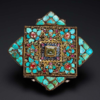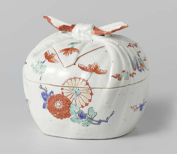BY NATALIE MARCHANT

THIS YEAR, OUR GALLERY celebrates its centenary. Marchant was founded in London in 1925 by my great grandfather, Samuel Sidney Marchant. Over the past century, through four generations of the family, the gallery has grown from a small enterprise dealing in general antiques into one of the most respected names in Chinese art. As we mark this milestone, we look back at our history and also forward, continuing our dedication to Chinese ceramics and works of art with renewed focus and energy.
To commemorate the occasion, we have published Marchant: One Hundred Years (2025), a two-volume work written by my father, Stuart Marchant. It brings together over 2000 photographs, historical records and personal reflections. This extensive publication is a record of our exhibitions, catalogues, landmark pieces, and also a tribute to the collectors, scholars, museum professionals and artists who have enriched our journey. The endpapers include a specially commissioned illustration, digitally drawn in the style of Qing dynasty (1644–1911) gouache albums, such as Yongzheng’s (1723–1735) Gu Wan Tu (Pictures of Ancient Playthings) (1728). It features some of our favourite pieces reimagined as if part of an imperial collection — a playful and personal homage to the tradition of cataloguing treasures (1).
This article reflects on our history through the lens of the centenary publication. It offers a personal account of how Marchant has developed across the decades, spotlighting people, artworks and ideas that have defined each era. From my perspective as a fourth generation member of the Marchant family involved in the business, I share stories that connect our present with our past — celebrating a legacy that we hope continues to contribute to the appreciation of Chinese art worldwide.

Foundations: 1925–1953
When the gallery was founded in 1925, London was already an established centre for art and antiques, but it was still possible for a young dealer with a good eye and a strong work ethic to make his mark. Samuel Sidney Marchant specialised early on in Chinese porcelain — a field rich with artistic depth and untapped potential. Without formal training, he relied on instinct and integrity, building a reputation for offering pieces that combined beauty with authenticity (2).
Sidney Marchant’s entrepreneurial spirit was paired with a deep respect for the objects he handled. It was not simply commerce to him, but a form of stewardship — a sense that the beauty and cultural significance of Chinese ceramics needed to be preserved and shared. Many of the pieces he acquired came from private European collections and English country houses, as well as from the regular and fruitful London auctions. He built a loyal clientele by encouraging an informed and personal appreciation of each object. He was also one of the earliest dealers to travel to Japan and Hong Kong, making frequent trips in the 1950s, enabling him to forge friendships that have lasted generations.
Scholarship and Expansion: 1953–1985
My grandfather, Richard Marchant, joined the business in 1953 at the age of eighteen. Under his stewardship, the gallery moved decisively towards a more scholarly approach. Richard was gifted at building relationships — with clients, fellow dealers, museum curators and academics. He broadened our scope beyond porcelain, cultivating an interest in scholar’s objects and early ceramics, setting the tone for an authoritative and educational ethos we still uphold.
The 1960s brought change: Chinese art collecting shifted from a predominantly European and American field towards Asia. New collectors in Hong Kong, Taiwan, Japan and, later, China sought to reconnect with a heritage dispersed or forgotten. Marchant embraced this transition, mindful that our role extended beyond commerce, to preserving Chinese cultural history.
Beyond catalogues and exhibitions, education has always been one of our corporate responsibilities. My grandfather understood this well; many of his earliest clients were new to the field, and he took time to explain each piece. Richard lectured at the Oriental Ceramic Society of Hong Kong in 1976 on “Some Interesting Pieces of Marked Ch’ing Porcelain”. My father, Stuart, has continued this tradition, delivering talks at museums, such as the Museum of New South Wales and in Melbourne, Australia (2014) (3) and the Cosmopolitan Club in New York (2019). His talks, like his catalogues, make complex material accessible without losing nuance. In our home city, we have participated in every season of Asian Art in London since its inception, and regularly host collectors — both new and experienced — eager to learn.

Focus and Refinement: 1985–2011
Stuart Marchant joined the business in 1985 after working at Christie’s London and with Alan Hartman, a renowned dealer in New York. Marchant then entered a period of extraordinary focus. Exhibitions became more specialised, regular and often themed — and the catalogues became key scholarly resources. Many of these catalogues, now out of print, are prized for their clarity and scholarship. Stuart’s eye for detail and uncompromising standards shaped Marchant’s modern identity. It is thanks to him that we are known not only for the quality of objects, but for the care with which we present them. His love of jade has also been passed down to me.
I grew up accompanying Stuart to auctions — weekends, school holidays and special trips, including to China in 2010 and Australia in 2014. I also occasionally assisted at fairs in New York and London. These experiences shaped my understanding of the art world, from the quiet concentration of viewing days to the thrill of discovering remarkable pieces or the buzz of an art fair (4).


A Fourth Generation Perspective: 2011–Present
After obtaining my degree in Visual Communications, I joined the gallery in 2010, working largely behind the scenes as photographer for every catalogue, website image, marketing campaign and social media post. This has given me an intimate understanding of how presentation shapes perception, and over the years, I have developed a strong visual voice for the gallery — one that aims to capture the elegance and subtlety of the objects we handle. I work closely with Stuart on all our design projects, and One Hundred Years has been a true labour of love, uniting rich content with an extensive archive of imagery.
For several years, I also ran our Chinese export gallery, where curating the space offered a fresh perspective on material that continues to fascinate collectors worldwide. These experiences broadened my appreciation of the business from artistic, commercial and interpersonal angles, reinforcing how interconnected each element of our work really is.
My brother, Samuel Marchant, joined the business in 2015. Working closely with Stuart as a buyer, he brings a sharp eye and deep market knowledge (5). Their collaborative approach reflects the best traditions of our family history, and it is always exciting to see how Samuel and Stuart’s combined expertise shapes each acquisition — often through hours of discussion, comparison and careful decision-making.
Bringing these strands together, and our shared commit commitment to preserving the gallery’s legacy, has shaped One Hundred Years into being far more than a book. It is a distillation of our family’s collective knowledge, passion and dedication, and a celebration of the people and objects that have defined a century of Marchant.



The Centenary and a New Chapter: 2025
This centenary year marks three milestones: the publication of One Hundred Years, our Centenary Exhibition and our move from Kensington Church Street (6) after seventy years to a completely renovated Georgian townhouse at 26 Brook Street, Mayfair. The new premises provides space for deeper displays, lectures and events, and strengthens our role in a global art market. The setting may be new, but our ethos remains constant: family-run, scholarshipdriven, and focused on the enduring beauty and complexity of Chinese art.
As we begin our second century, we will continue to explore our established areas of interest whilst also engaging with contemporary artists. In 2022, we exhibited the celadon works of Kawase Shinobu (born 1950), the acclaimed Japanese ceramicist, becoming the first gallery outside Japan or America to present a comprehensive retrospective of his work (7).
Marking 100 years is both a culmination and a beginning. One Hundred Years and our Centenary Exhibition (8) celebrate not only the objects and collectors who have shaped Marchant, but also the enduring importance of cultural heritage itself. Our hope is that, for generations to come, Marchant will remain a place where beauty, scholarship and personal connection come together to inspire…
Please click here to view the contents of this issue.

 Subscribe
Subscribe Calendar
Calendar Links
Links Gift
Gift


